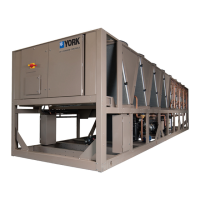SECTION 1 - GENERAL CHILLER INFORMATION AND SAFETY
JOHNSON CONTROLS
13
Form 201.28-NM1.1
Issue date: 08/06/2021
1
Structural support
Structural support of the unit must be provided as in-
dicated in these instructions. Failure to provide proper
support may result in injury to the operator, or damage
to the equipment and/or building.
Mechanical strength
The unit is not designed to withstand loads or stresses
from adjacent equipment, pipework or structures. Ad-
ditional components must not be mounted on the unit.
Any such extraneous loads may cause structural failure
and may result in injury to the operator, or damage to
the equipment.
General access
There are a number of areas and features, which may
be a hazard and potentially cause injury when working
on the unit unless suitable safety precautions are taken.
It is important to ensure access to the unit is restricted
to suitably qualified persons who are familiar with the
potential hazards and precautions necessary for safe
operation and maintenance of equipment containing
high temperatures, pressures and voltages.
Pressure systems
The unit contains refrigerant vapor and liquid under pres-
sure, release of which can be a danger and cause injury.
The user should ensure that care is taken during installa-
tion, operation and maintenance to avoid damage to the
pressure system. No attempt should be made to gain ac-
cess to the component parts of the pressure system other
than by suitably trained and qualified personnel.
Electrical
The unit must be grounded. No installation or main-
tenance work should be attempted on the electrical
equipment without first switching power OFF, isolat-
ing and locking-off the power supply. Servicing and
maintenance on live equipment must not be attempted.
No attempt should be made to gain access to the con-
trol panel or electrical enclosures during normal opera-
tion of the unit.
Caution:
This equipment (Class A, Group 1) is designed and
manufactured for use in an industrial environment, in
accordance with EN 61000-6-2:2005 and EN 61000-6
4:2007 (with EN 55011:2007 limits). It is not intended
to be used on a low-voltage public network which sup-
plies domestic premises. Radio frequency interference
may occur if it is used on a low voltage public network.
This equipment equipped with VSD, may generate
conducted and radiated disturbances, which may inter-
fere with or damage susceptible connected apparatus.
Generally accepted engineering standards and practic-
es should be followed to ensure trouble-free and EMC
compliant electrical installation. Installations must
be supervised or completed by a competent person in
accordance with EN 13313.
Special considerations depending on the application:
• Industry standard grounding or “earthing”
practices for the equipment and installation.
• Use of shielded or special cables (power and/or
control).
• Use of metallic conduit and/or cable trays for
power and control cables connected to equipment.
• Cable segregation (in order to avoid the risk of
crosstalk or cross interference to signal cables,
the power cables must be segregated from signal
cables).
• Dedicated isolation transformer.
•
It is the responsibility of a designated System Integra-
tor to take proper steps assuring the Electromagnetic
Compatibility of both equipment and installation as a
system.
Rotating parts
Fan guards must be fitted at all times and not removed
unless the power supply has been isolated. If ductwork
is to be fitted, requiring the wire fan guards to be re-
moved, alternative safety measures must be taken to
protect against the risk of injury from rotating fans.
Sharp edges
The fins on the air-cooled condenser coils have sharp
metal edges. Reasonable care should be taken when
working in contact with the coils to avoid the risk of
minor abrasions and lacerations. The use of gloves is
recommended.
Frame rails, brakes, and other components may also
have sharp edges. Reasonable care should be taken
when working in contact with any components to avoid
risk of minor abrasions and lacerations.

